Pushkin Museum Town: three concepts
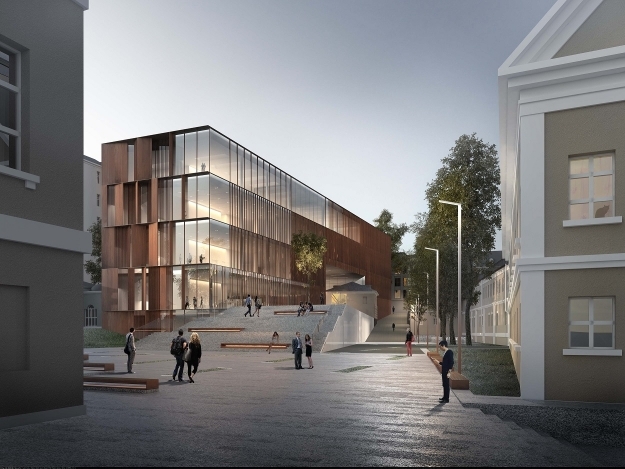
We present a detailed analysis of the three projects that participated in a closed competition to develop an architectural concept of the expansion of the Pushkin Museum of Fine Arts. The final version of the project developed by the winning bureau Project Meganom must ultimately take into account the strengths of all three concepts.

Innovation
The most detailed concept of forming the Pushkin Museum Town was submitted Sergey Skuratov Architects. It is obvious that the intention was to consolidate the many varying Volkhonka buildings and adjacent lanes into a cohesive architectural and landscaped ensemble, which in its planning and proportional structure resembles early 20th century neoclassicism. Three quarters of the complex are grouped around the historic main building of the Pushkin Museum. Equidistant on either side of its front facade two new buildings are planned.
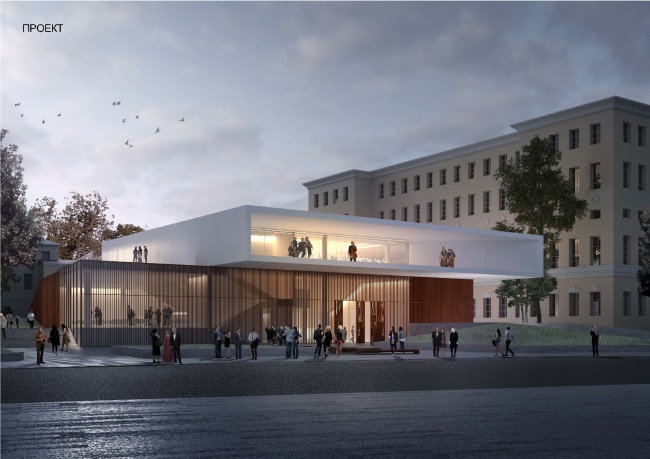
The western pavilion is to open the entrance to the “town” from Prechistenskie Vorota and Gogolovskiy Boulevard. Directly under this building S. Skuratov and his colleagues propose to create a new exit out of the metro. Another functionality of the pavilion is to serve as a venue for various types of museum activities in the evening.
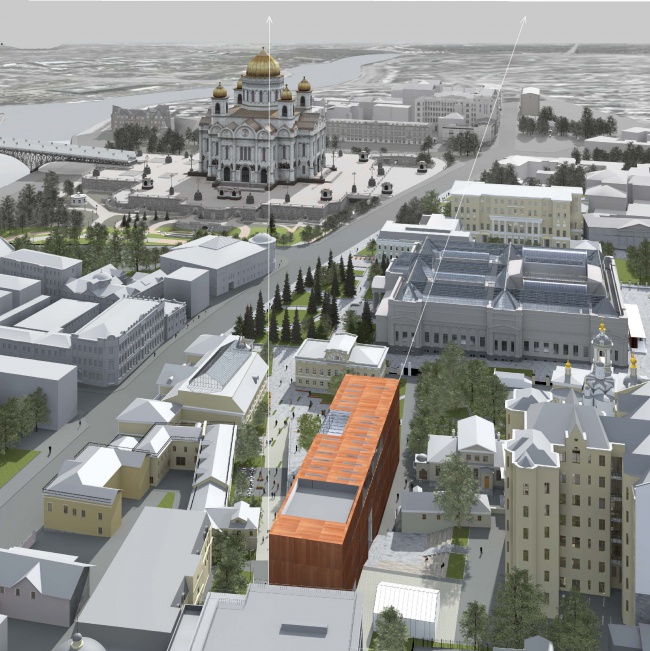
To the east of the main building, which was built over a hundred years ago, the authors of the project envisioned to build a large extended volume of the Depository and Restoration Exhibition Center. The new building, which stretches parallel to Volkhonka, is located between the Empire-style manor that goes by the name of the Verstovsky House (1826) where the graphics department is situated, and the tenement building of the Stulova brothers (1914), into which it is planned to transfer the library and some of the administrative departments of the museum.
The location of the Depository and Restoration Exhibition Center in the town opens new striking visual connections, including with the Cathedral of Christ the Savior. Correlating in size and proportions with the basic structural module of Klein’s main building, it becomes the new compositional focus not only of the created town, but also of the entire district. With its simple rectangular shape, it is perceived as a neutral background for more sculptural historic buildings. At the same time, in the pronounced contrast to the surrounding bright colors, such a large construction has an ambitious challenge. When viewed from afar Skuratov’s building should look like a new Moscow “point of power,” like the converted Danilovskaya Manufactory.
In close-up renderings this site is positioned more as an expensive and highly eccentric “jewelry box” for museum treasures. The metaphor is effectively materialized — in the lower part of the building a huge “cut-out” is designed in which a restored neoclassical two-story manor is to be hidden from the vicissitudes of time.
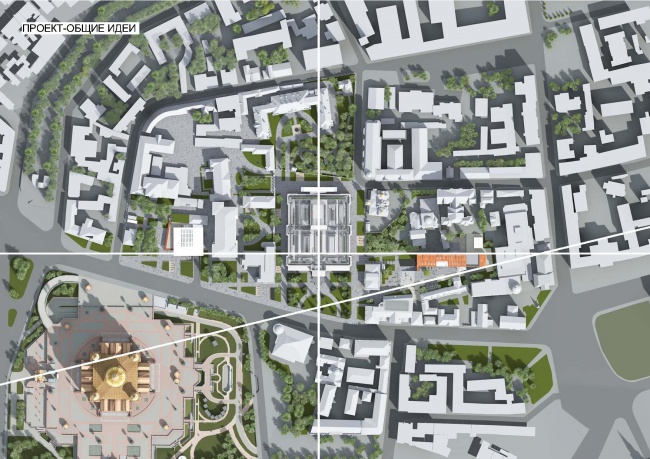
S. Skuratov proposes to seriously reconstruct the main building of the museum itself. A new entrance is planned to be created through a detached glass vestibule on Maliy Znamenskiy Lane. The interior of the old Pushkin Museum as a whole retains its historic character, but it is planned to add a system of elevators and escalators. Due to the overlap of the courtyards and the creation of an underground floor with showrooms and depositories, the museum gets 6500 square meters of effective area in accordance with the project.

The underground space of the Museum Town as a whole is expected to be used very actively — it’s to include three freight handling centers, providing autonomous life sustainment in each of the quarters, parking, communication systems and various auxiliary buildings. Thanks to a well-designed logistical arrangement, the entire complex turns into a comfortable recreation area, a genuine open-air museum, designed for visits by thousands of Muscovites and tourists daily.
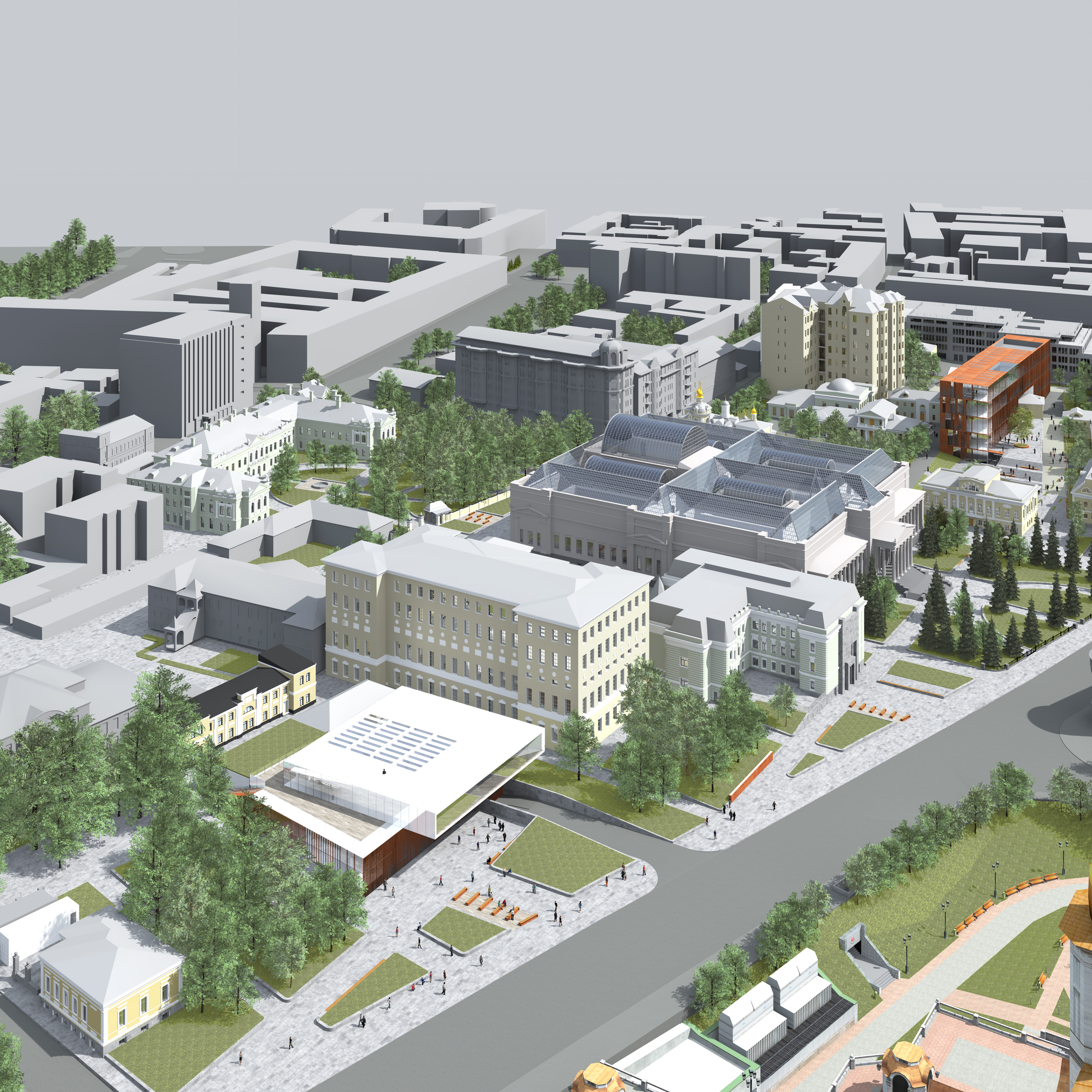
However, the decision to demolish the 1930s gas station, which has a conservation status, opposite the Cathedral of Christ the Savior certainly drove the otherwise very high chances of Sergey Skuratov’s bureau to win the competition down to zero.
Dialogue
The team of TPO Reserve under the leadership of Vladimir Plotkin emphasized more small-scale tasks. The main focus of this concept is given to the paving of streets, small architectural forms, outdoor sculptures, lighting elements and details of landscape beautification. The idea of a unified space of an updated Pushkin Museum is very clearly embodied in the intention to establish throughout the town a natural stone pavement with various types of patterns based on the ornamental designs of the Pushkin Museum’s historic floors.
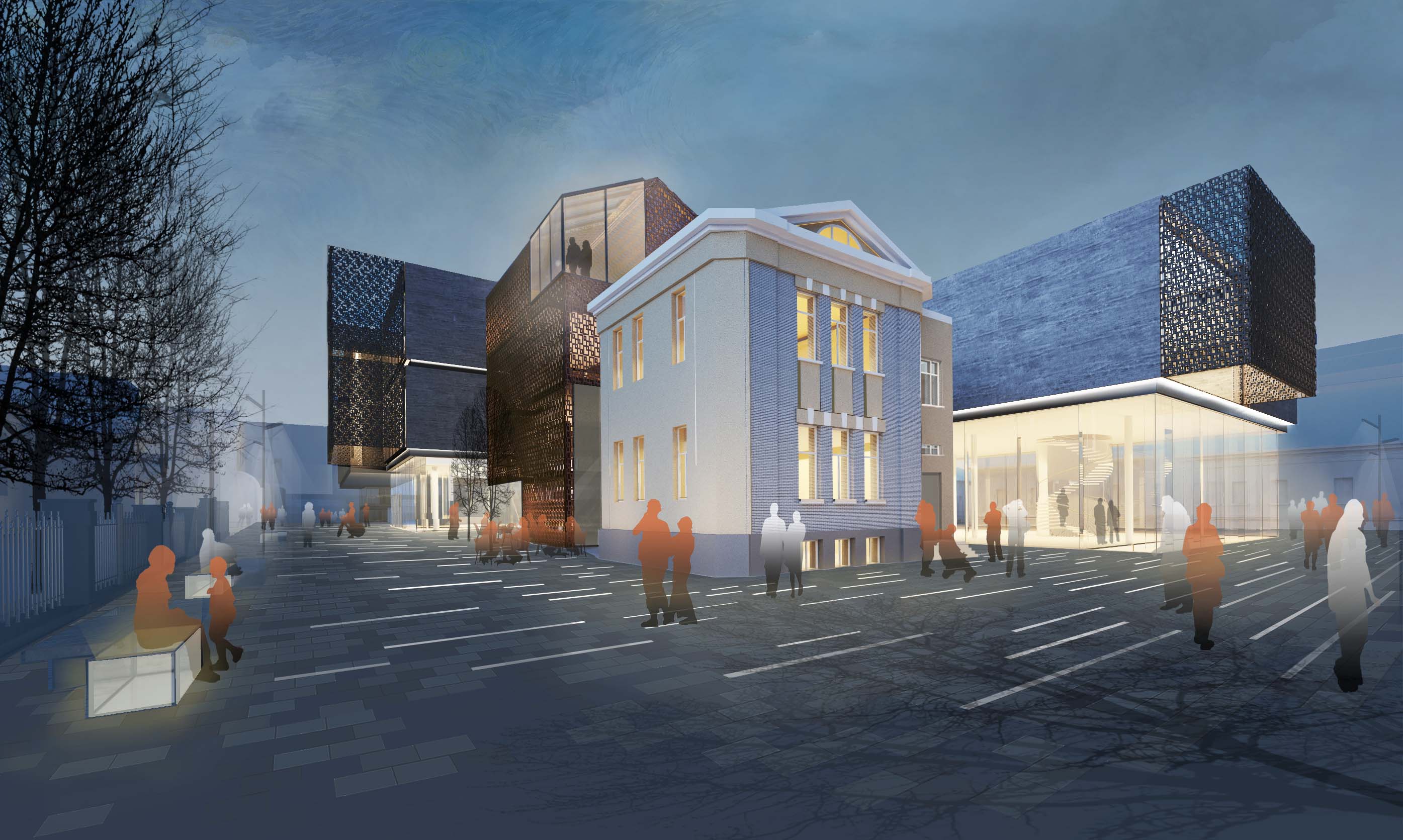
The architects of Reserve see their main task as the transformation of the reconstructed fragment of center of Moscow into “a garden of sculpture and events” where creations of the past and present will be placed in the shade of evergreen trees. The architects of Reserve want to allocate more intense lighting to the most significant segments of the complex, proposing that various “tricks” with the light will help influence the routes and visitors’ speed of movement. Media projections onto the facades of the main building are proposed to be included as part of the permanent “show.”
The town, according to the designers, should be a venue for year-round outdoor performances, where artists that work in the open air and creators of ice sculptures will be invited.
The main entrance to the museum complex is proposed to be established from the side of Maliy Znamenskiy Lane: pedestrian flow from the Kremlin’s Borovitskiye Gates is to be directed there through Znamenka Street. Vladimir Plotkin plans to equip almost all the buildings of the Museum Town with permanent exhibition space. The majority of them are to stay in the immediate vicinity of museum shops and cafes.
The gas station on Volkhonka also found a new use — it turns into a ticket office and information pavilion. The surrounding territory is named “Summer Lounge” and reinvented as a space for relaxation, where in addition to all other elements of landscape beautification, the creation of a small pond is proposed. The architects of TPO reserve decided to do away with the historic linden tree walkway that is located there.
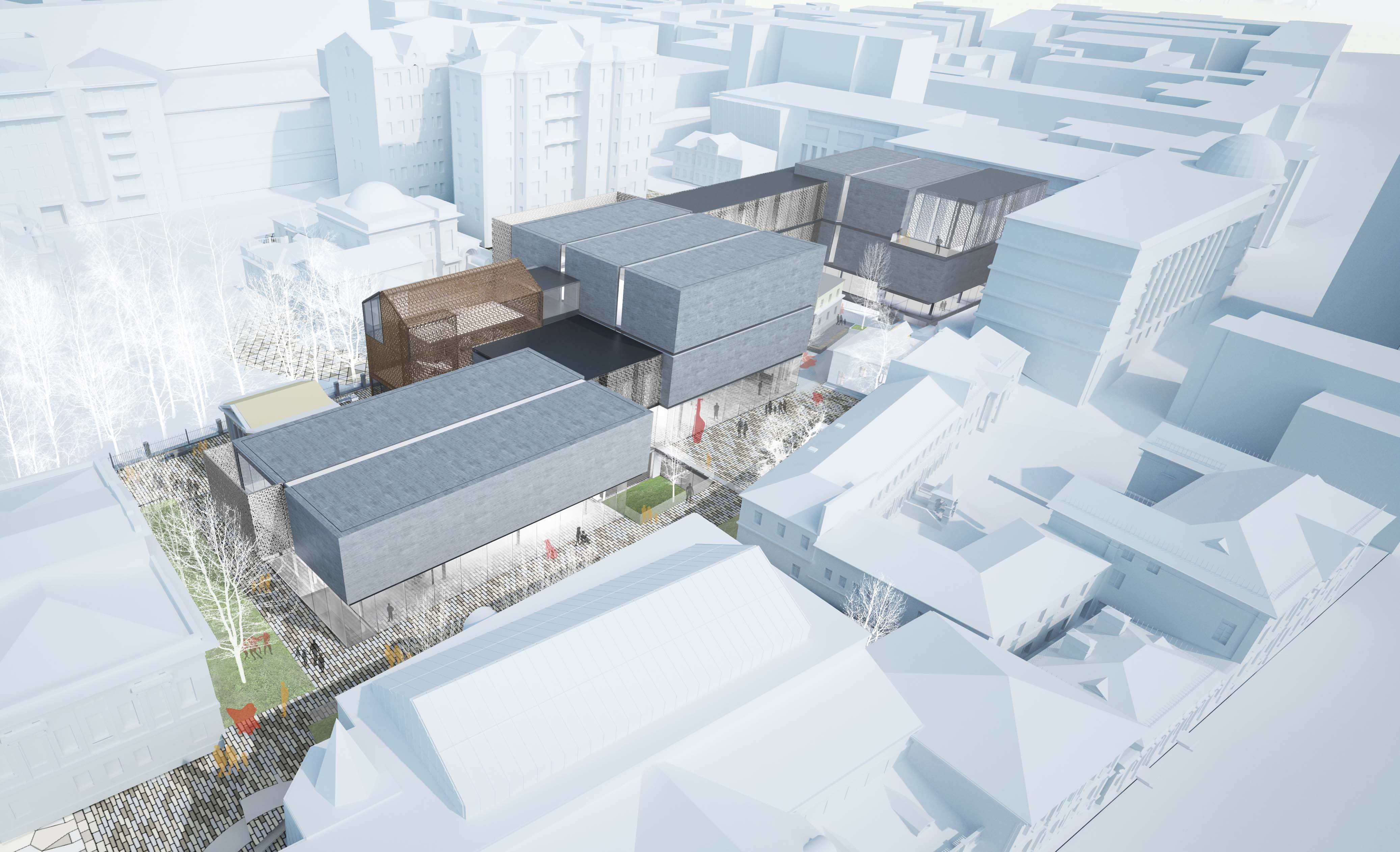
The new museum building in the eastern part of the complex is almost a Suprematist combination of small geometrical volumes with the massive neighboring old manor. The translucent walls of this building, which itself does not aim to be monumental, is not only a sign of the commitment of the project’s authors to the aesthetics of modernism, but also a kind of a gallant compliment to the glass dome of the main building by R. Klein. The upper floors are proposed to be faced with a natural stone with a context-sensitive hue of light-gray.
The very same building that Sergey Skuratov fit into his version of the Depository and Restoration Exhibition Center blends quite naturally into the ensemble of buildings. Upon looking out of the glazed premises of the ground floor, the surrounding historical buildings should be seen as the largest exhibits of the museum’s collection.
The restoration workshops, storage, and engineering block which are closed to the public are located underground. One of the exhibition halls acting simultaneously as a passage to the main building is planned to be located there as well.
According to the authors, “the new building organically fits into the complex context of the surrounding environs.” As noted by Marina Lochak, Director of the Pushkin Museum, the project of TPO Reserve is of particular subtlety and delicacy. However, it did not win — perhaps due to the fact that for most members of the jury the amount of glass on the facade of the new building seemed superfluous.
Synthesis
The winning team of authors led by Yuri Grigoryan very symbolically named their work: “Rhizosphere. New Ground.” Glancing in Wikipedia, it’s easy to find out that the rhizosphere is “the narrow region of soil that is directly influenced by root secretions and associated soil microorganisms.” This is a very clear and precise metaphor of the project’s essence, aimed at successive development of the territory through the comprehension of organic patterns in the interaction between Klein’s main building and the surrounding buildings.
According to the architects of Meganom, it is necessary to preserve not only officially recognized monuments of historical and cultural heritage, but also ordinary buildings of the past centuries. The subject of museification, the authors argue, should be the urban environment itself, acquiring a new quality as a result of the reconstruction: “Here everything is like in Moscow and little else — all the buildings become a unified collection of architecture , a public space full of art.”
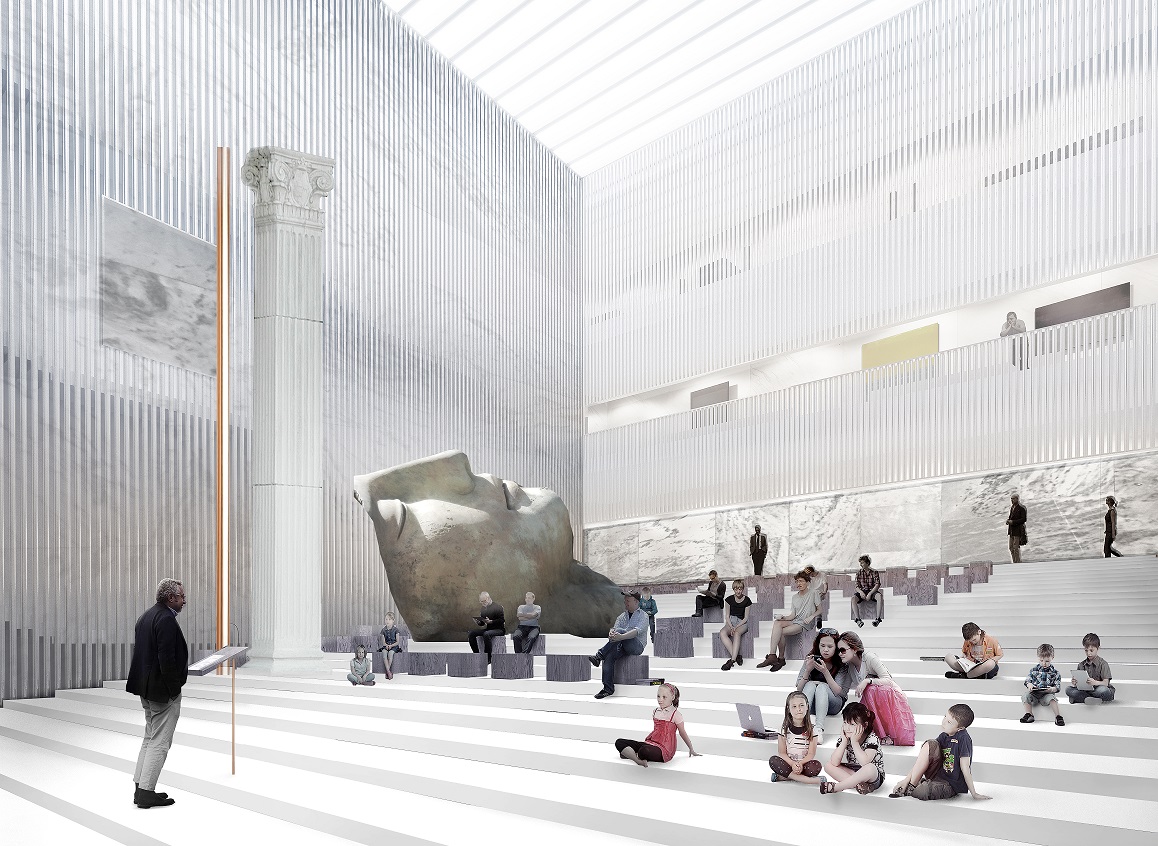
Museification even of the flora: each of the existing trees gets a tag of protection and its own name. The future collection of plants is intended to expand according to a unified plan, closely linked with the general concept of the museum’s development: for example, near the Impressionist exhibition, the architects are planning to plant shrubs that are similar to those depicted in the paintings of Monet and Signac.
The entire territory of the town is planned to be paved with granite of various textures with additions of iron and bronze details. Wide pedestrian spaces will be accented by large slabs. Park paths will be paved with small stone blocks. The paving pattern supports all elements of the redevelopment. Part of the paving system is to be equipped with winter heating using heat energy generated by the metro. For the convenience of visitors, there will be plenty of seating situated throughout the area, as well as a unified system of stationary objects with navigation and information.
The town gets a clear internal structuring — there will be nine areas with their own names, as well as several avenues, streets and driveways. It is proposed for the areas to function on a regular basis as a space for the museum’s public events of its educational programs and as an open-air exhibition of art. Volkhonka street is proposed to be made into the main boulevard of Project Meganom’s system, with trees planted along it after a significant narrowing of the roadway. This solution will allow the rhizosphere to be organically linked with the pedestrian area of the Cathedral of Christ the Savior, including the Patriarchal Bridge. Vehicular traffic within the complex will be limited to a minimum, specified by the necessity of loading and unloading works in the exposition and storage spaces.
.jpg)
In the concept by Yuri Grigoryan and his co-authors, the most representative part of the street exhibition is organized in the area between the main building and a newly built complex. The Depository and Restoration Exhibition Center, pursuant to the project, will be an ensemble of compact monumental volumes, forming a medieval type area. New space for exhibitions of special significance will be located in the Agora with a multi-colored, 12 m high large hall in the center and several galleries around the perimeter. The entrance to an additional exhibition space located underground will also be situated there.
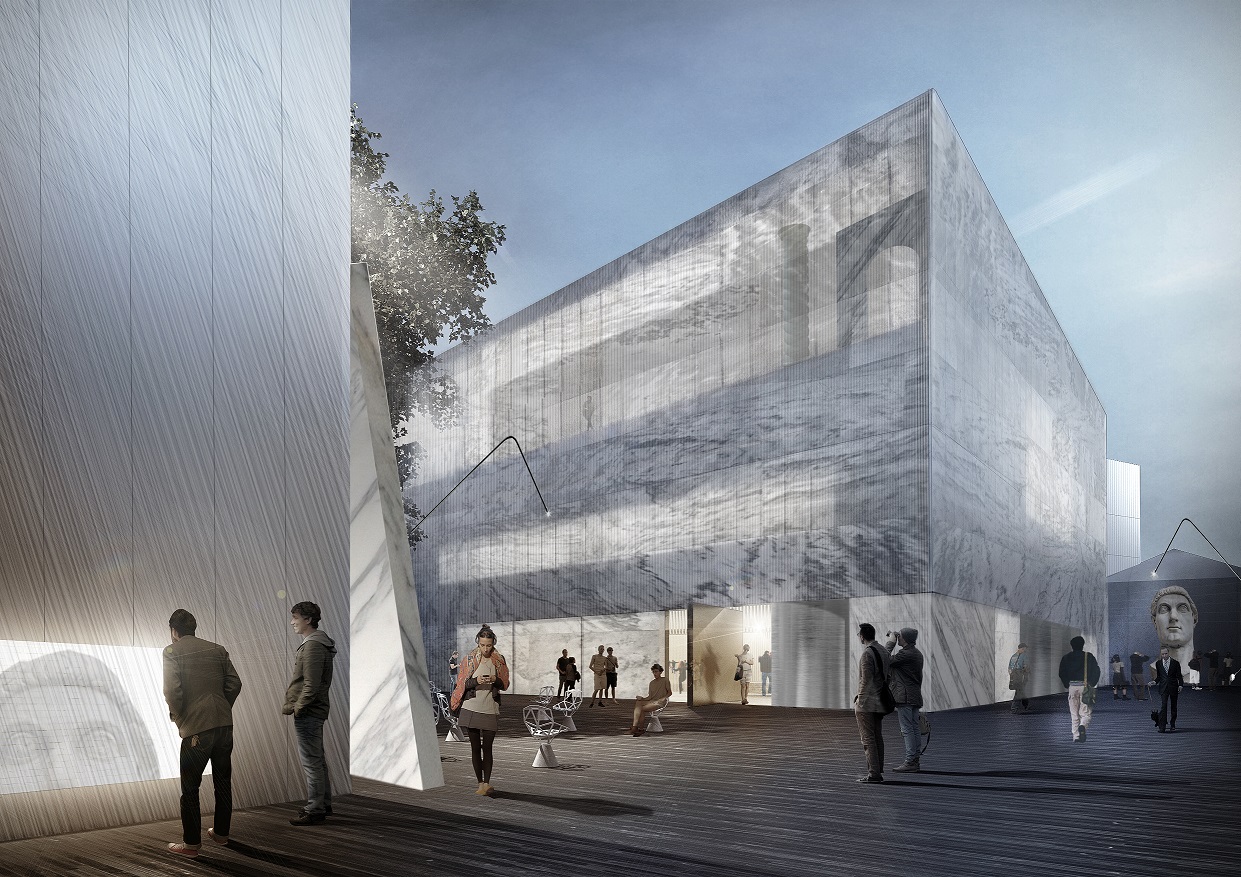
The engineering block is to consist of two visually separate parts, one of which is named Safe intended for museum storage, and another — for restoration work. For the exterior finish of this building, the architects of Meganom propose to use gray aluminum panels. The facades of Agora are planned to be executed in a similar color scheme, but out of translucent panels with attachments of thin, light gray marble details of varying thickness, and treatments at the top, and granite blocks at the bottom.
There will not be imitation of the surrounding buildings but a deliberate visual contrasting of the new sites. The ensemble will add two reconstructed historical buildings, and it is planned to make “contextual” applications of marble on the facade of one of them.
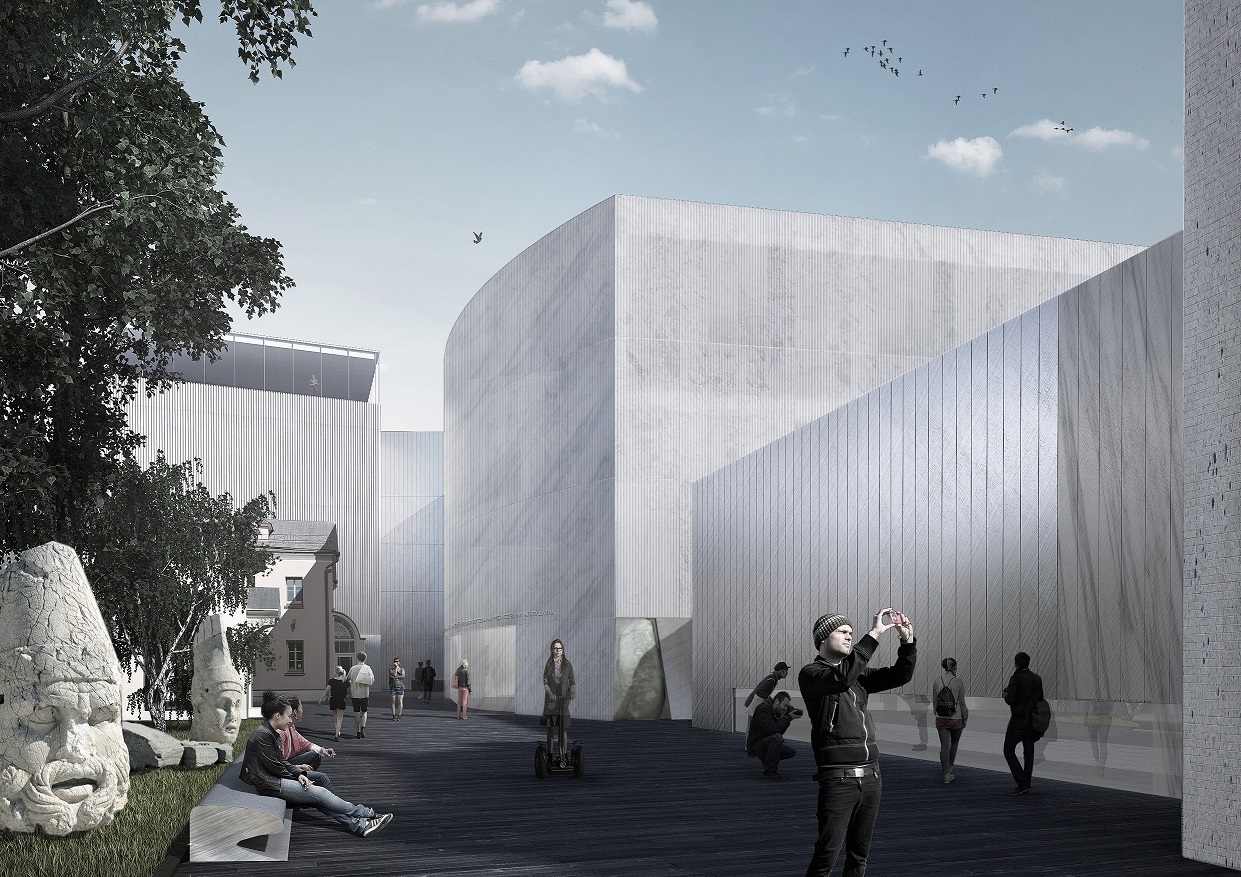
The gas station opposite the Cathedral of Christ the Savior is to be an integral part of the pavilion in the project, opening an entrance to the “town.” This lightweight construction is planned to be set on the roof of a newly created underground space, which the authors suggest to be used either as a parking garage, or as another exhibition hall.
The competition’s jury and the management of the Pushkin Museum consider the main advantage of this concept is the priority given to the space of the Museum Town as a whole. Undoubtedly, many details of the project will continue to be refined, but the main direction of the forthcoming comprehensive reconstruction of the historic areas north of Volkhonka has already been determined.
For more information about the Pushkin Museum competition, see here.
- Tags:
- competitions |
- heritage |
- museums |
- Yuri Grigoryan |
- Vladimir Plotkin |
- Pushkin Museum





